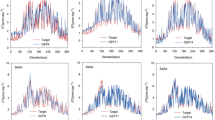Abstract
Accurate estimation of rainfall has an important role in the optimal water resources management, as well as hydrological and climatological studies. In the present study, two novel types of hybrid models, namely gene expression programming-autoregressive conditional heteroscedasticity (GEP-ARCH) and artificial neural networks-autoregressive conditional heteroscedasticity (ANN-ARCH) are introduced to estimate monthly rainfall time series. To fulfill this purpose, five stations with various climatic conditions were selected in Iran. The lagged monthly rainfall data was utilized to develop the different GEP and ANN scenarios. The performance of proposed hybrid models was compared to the GEP and ANN models using root mean square error (RMSE) and coefficient of determination (R2). The results show that the proposed GEP-ARCH and ANN-ARCH models give a much better performance than the GEP and ANN in all of the studied stations with various climates. Furthermore, the ANN-ARCH model generally presents better performance in comparison with the GEP-ARCH model.










Similar content being viewed by others
Explore related subjects
Discover the latest articles and news from researchers in related subjects, suggested using machine learning.References
Abbot J, Marohasy J (2014) Input selection and optimisation for monthly rainfall forecasting in Queensland, Australia, using artificial neural networks. Atmos Res 138:166–178
Ashraf B, Yazdani R, Mousavi-Baigy M, Bannayan M (2014) Investigation of temporal and spatial climate variability and aridity of Iran. Theor Appl Climatol 118(1–2):35–46
Behmanesh J, Mehdizadeh S (2017) Estimation of soil temperature using gene expression programming and artificial neural networks in a semiarid region. Environ Earth Sci. https://doi.org/10.1007/s12665-017-6395-1
Chinchorkar SS, Patel GR, Sayyad FG (2012) Development of monsoon model for long range forecast rainfall explored for Anand (Gujarat-India). Int J Water Resour Environ Eng 4(11):322–326
Delleur JW, Karamouz M (1982) Uncertainty in reservoir operation. Optimal Allocation of Water Resources (Proceedings of the Fxeter Symposium), IAHS Publication no. 135:7–16
Ebtehaj I, Bonakdari H, Zaji AH, Azimi H, Sharifi A (2015) Gene expression programming to predict the discharge coefficient in rectangular side weirs. Appl Soft Comput 35:618–628
Engle RF (1982) Autoregressive conditional heteoscedasticity with estimates of the variance of United Kingdom inflations. Econometrica 50(4):987–1007
Feng Q, Wen X, Li J (2015) Wavelet analysis-support vector machine coupled models for monthly rainfall forecasting in arid regions. Water Resour Manag 29(4):1049–1065
Ferreira C (2001) Gene expression programming: a new adaptive algorithm for solving problems. Complex Syst 13(2):87–129
Gocic M, Motamedi S, Shamshirband S, Petkovic D, Ch S, Hashim R, Arif M (2015) Soft computing approaches for forecasting reference evapotranspiration. Comput Electron Agric 113:164–173
Haykin S (1998) Neural networks-a comprehensive foundation, 2nd edn. Prentice-Hall, Upper Saddle River, pp 26–32
He X, Guan H, Qin J (2015) A hybrid wavelet neural network model with mutual information and particle swarm optimization for forecasting monthly rainfall. J Hydrol 527:88–100
Imani M, You RJ, Kuo CY (2014) Forecasting Caspian Sea level changes using satellite altimetry data (June 1992–December 2013) based on evolutionary support vector regression algorithms and gene expression programming. Glob Planet Chang 121:53–63
Kashid SS, Maity R (2012) Prediction of monthly rainfall on homogeneous monsoon regions of India based on large scale circulation patterns using genetic programming. J Hydrol 454–455:26–41
Khalili K, Nazeri Tahroudi M, Mirabbasi R, Ahmadi F (2016) Investigation of spatial and temporal variability of precipitation in Iran over the last half century. Stoch Environ Res Risk Assess 30(4):1205–1221
Kisi O, Cimen M (2012) Precipitation forecasting by using wavelet-support vector machine conjunction model. Eng Appl Artif Intell 25(4):783–792
Marti P, Shiri J, Duran-Ros M, Arbat G, de Cartagena FR, Puig-Bargues J (2013) Artificial neural networks vs. Gene Expression Programming for estimating outlet dissolved oxygen in micro-irrigation sand filters fed with effluents. Comput Electron Agric 99:176–185
Mehdizadeh S, Behmanesh J, Khalili K (2016) Comparison of artificial intelligence methods and empirical equations to estimate daily solar radiation. J Atmos Sol Terr Phys 146:215–227
Mehdizadeh S, Behmanesh J, Khalili K (2017) Application of gene expression programming to predict daily dew point temperature. Appl Therm Eng 112:1097–1107
Mekanik F, Imteaz MA, Gato-Trinidad S, Elmahdi A (2013) Multiple regression and artificial neural network for long-term rainfall forecasting using large scale climate modes. J Hydrol 503:11–21
Moustris KP, Larissi IK, Nastos PT, Paliatsos AG (2011) Precipitation forecast using artificial neural networks in specific regions of Greece. Water Resour Manag 25(8):1979–1993
Partal T, Kisi O (2007) Wavelet and neuro-fuzzy conjunction model for precipitation forecasting. J Hydrol 342(1–2):199–212
Ramirez MCV, de Campos Velho HF, Ferreira NJ (2005) Artificial neural network technique for rainfall forecasting applied to the Sao Paulo region. J Hydrol 301(1–4):146–162
Shenify M, Danesh AS, Gocic M, Taher RS, Abdul Wahab AW, Ghani A, Shamshirband S, Petkovic D (2016) Precipitation estimation using support vector machine with discrete wavelet transform. Water Resour Manag 30(2):641–652
Shiri J, Keshavarzi A, Kisi O, Iturraran-Viveros U, Bagherzadeh A, Mousavi R, Karimi S (2017) Modeling soil cation exchange capacity using soil parameters: assessing the heuristic models. Comput Electron Agric 135:242–251
UNEP (1992) World atlas of desertification. The united nations environment programme (UNEP), London
Venkata Ramana R, Krishna B, Kumar SR, Pandey NG (2013) Monthly rainfall prediction using wavelet neural network analysis. Water Resour Manag 27(10):3697–3711
Wu CL, Chau KW, Fan C (2010) Prediction of rainfall time series using modular artificial neural networks coupled with data-preprocessing techniques. J Hydrol 389(1–2):146–167
Yassin MA, Alazba AA, Mattar MA (2016) A new predictive model for furrow irrigation infiltration using gene expression programming. Comput Electron Agric 122:168–175
Zanetti SS, Sousa EF, Oliveira VP, Almeida FT, Bernardo S (2007) Estimating evapotranspiration using artificial neural network and minimum climatological data. J Irrig Drain Eng 133(2):83–89
Acknowledgements
The authors of the paper would like to thank the anonymous reviewers for their constructive comments, as well as the Islamic Republic of Iran Meteorological Organization (IRIMO) to provide the monthly rainfall data for the present study.
Author information
Authors and Affiliations
Corresponding author
Rights and permissions
About this article
Cite this article
Mehdizadeh, S., Behmanesh, J. & Khalili, K. New Approaches for Estimation of Monthly Rainfall Based on GEP-ARCH and ANN-ARCH Hybrid Models. Water Resour Manage 32, 527–545 (2018). https://doi.org/10.1007/s11269-017-1825-0
Received:
Accepted:
Published:
Issue Date:
DOI: https://doi.org/10.1007/s11269-017-1825-0




